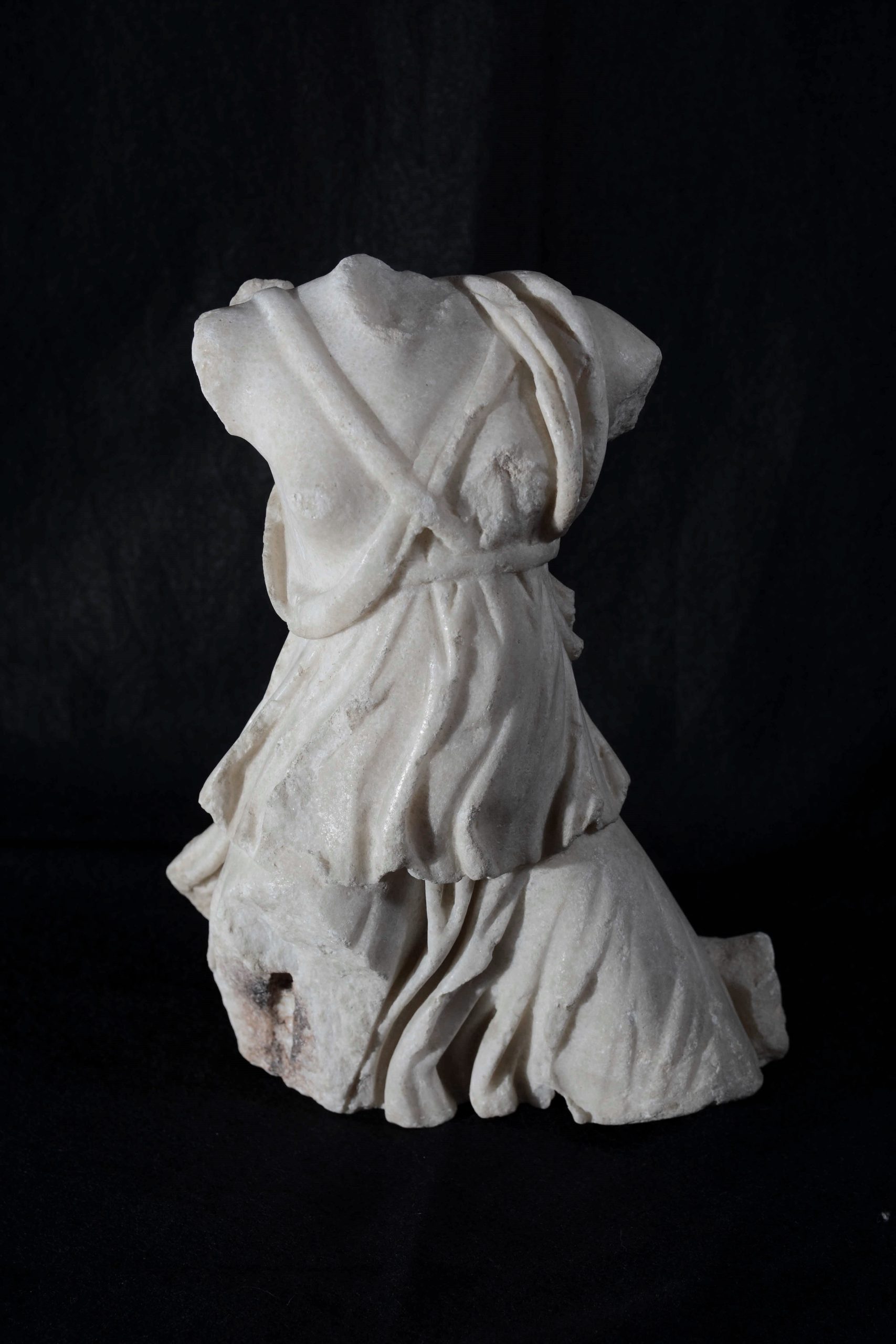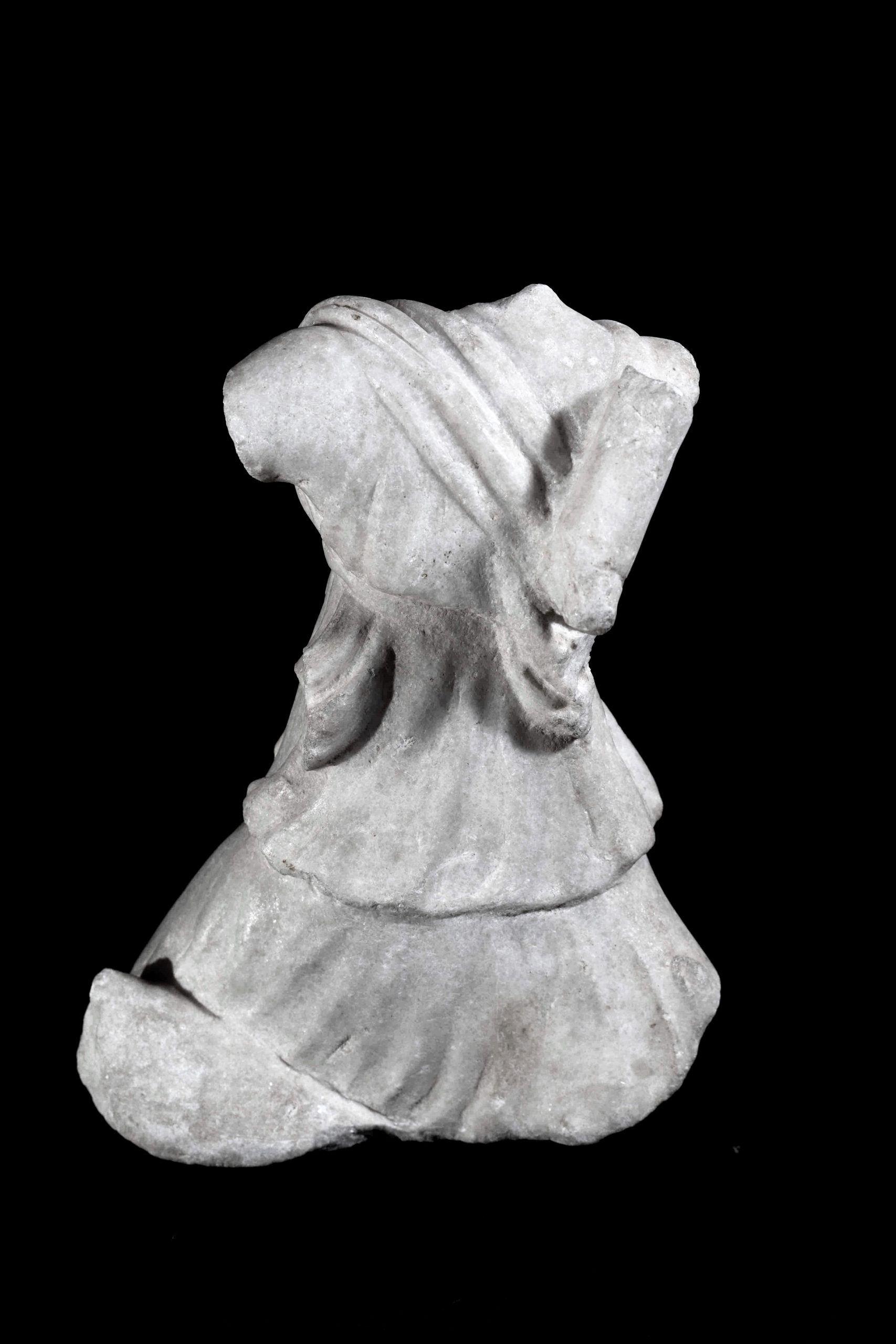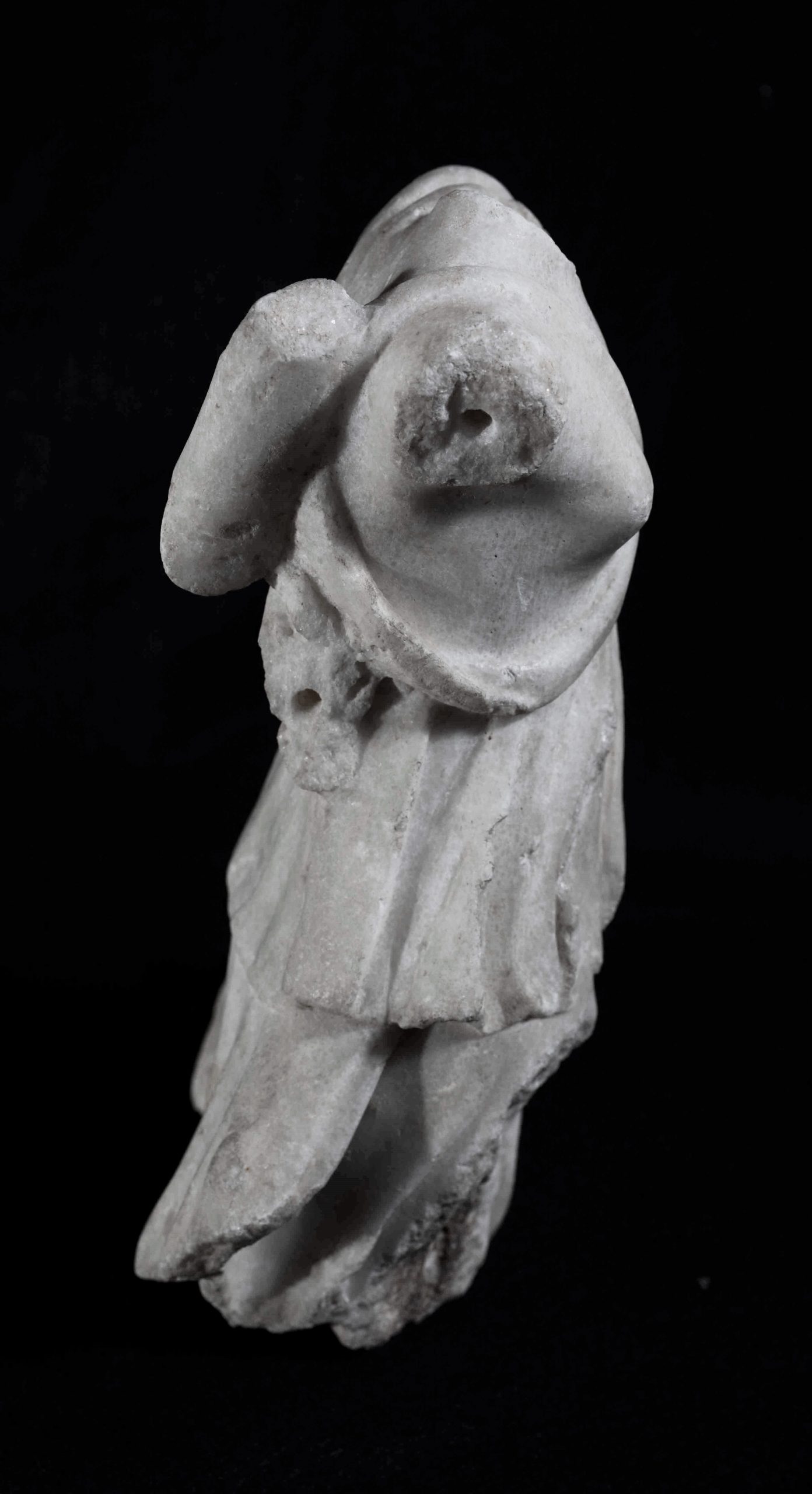I.D. no: 48916
Dimensions: Max. H. 28 cm; max. W. 19 cm.
Material: Medium-grain white marble, possibly ‘Parian’[1]
Provenance: Unknown[2]
Current location: Domvs Romana Museum
Condition: Missing head, broken off at the bottom of the neck, and lower part of the torso, broken off just above the knees. Also broken off is the front part of the right thigh from below the hip down, originally held in place by a vertical iron dowel, judging from the surviving hole and traces of rust. Both arms missing, and the right one was also served with a dowel. Also missing are the projecting ends of the two drapery clusters flowing behind the high belt. The animal behind the left leg is headless and worn beyond recognition. Smaller chippings on the breasts and crests of drapery all over.
Description:
The youthful female deity is shown in the fast movement to the right. The upper part of the torso is almost total frontality but the thighs face in different directions: the left one, which takes all the body’s weight, is seen in profile and projected forward while the right one faces the spectator.
She is dressed in a light chiton that bares the right breast and flows loosely down to the level of the knees. It has a long overfold tightened by a high belt, beneath the breasts. Over the chiton the figure wears also a short mantle (chlamys) folded into a roll which passes over the left shoulder and crosses obliquely from the back to the right waist. Both of its ends are secured by the high belt. Behind the right shoulder is a quiver held in place by a balteus that crosses the chest between the breasts and fades under the mantle. Judging from the comparative typology discussed below, the left arm must have held the bow while the right hand was raised towards the quiver. Behind the left thigh is the trunk of an almost unrecognizable body of an animal, most probably a dog.
Discussion:
There is no doubt that this small torso represents Artemis/Diana in a hunting role and in Amazonian attire. It thus belongs to an iconographic type inspired by a prototype probably created in the 4th c. BC and frequently reproduced with several modifications in both the Hellenistic and Roman periods.[3] These modified versions fall under different types classified according to variations in the direction of motion and in a dress. Of the various representations of the goddess in different media the closest parallels to the Maltese torso are: a) a torso from Carthage, of the same size;[4] b) two bronze figurines, one in the Newton-Robinson Collection, the other in Portogruaro;[5] c) the altar of Aelia Procula in the Louvre;[6] and d) two sarcophagi, one in Munich[7] and the other in the Vatican.[8] To these one might well add a Corinthian lamp,[9] a medallion of Antoninus Pius[10] and an oscillum formerly in the antiquarian market.[11] These, together with the Malta torso, were classified by H. Marvitz under his Typus IV which differs from Typus III only because its left breast is bare.[12]
Out of all the representations he listed, which are limited to small-scale free-standing statuettes and Roman relief representations, Sestieri considered the Maltese statuette as the nearest to the original[13]. On the basis of a passage from Pausanias (X, 37, 1), he thought he could establish that the original prototype was a cult statue by Kephisodotos, son of Praxiteles, the existence of which in Rome was mentioned by Pliny (N.H. xxxvi. 24).[14]
More recently Sestieri’s close association of the Maltese statuette with the Rospigliosi type has been restated by the compiler of the lemma of Artemis/Diana in the LIMC.[15]
On the whole, the spiralling composition of the figure and the flame-like rhythm of the fluttering drapery add quality to the aesthetic merits of the piece. The chiaroscuro effect created by the deep grooves of the drapery contrasts with the delicate and sfumato modelling of the bare parts of the body. A certain degree of anatomical disproportion between the longish and broadish midriff and the smallish thorax is not unknown in the female statuary of the Hellenistic age. Some inconsistencies are also noted in the drapery, such as the interruption of the horizontal belt under the right breast which defies all logic. In baring the right breast the sculptor failed to provide for the continuity of this horizontal belt beyond the drooping upper edge of the chiton.
Plenty of deep undercutting in the thick folds between the legs and underneath, between the front and back ends of the tunic, adds to the pleasant naturalistic effect, without any apparent use of the running drill. A much flatter treatment of the drapery is noted at the back, suggesting a frontal vision only.
Date: Roman copy, probably 1st c. BC-1st c. AD, of a Hellenistic original.
Bibliography: (previous publications of item):
Ashby 1915: 77 (“both breasts are bare [sic]…provenance unknown”). Zammit 1919: 25: “quiver at the back fastened by a strap”. Sestieri 1939 (comprehensive study; regarding provenance he confuses it with a larger torso of Amazon in the same collection and, therefore, in note 2 gives the wrong provenance as the “harbour”). Sestieri 1941: 112-14, fig. 3 (repeats the wrong provenance in note 20). Marvitz 1967: 53 (classified under Type 4). Bonanno 1971: 72-77. Simon 1984: no 32 a).
[1] Ashby 1915: 77. Sestieri 1939: 152, note 2 identifies it as “marmo bianco, insulare, a grana non molto fine, con patina leggermente dorata (grechetto)”.
[2] Sestieri (1939: note 2; 1941: note 20) confuses this statuette with a headless torso of Amazon which was found in 1865 in the sea at the Grand Harbour (this catalogue ID no 102539).
[3] See, among others, the discussion, supported by previous bibliography, in Calza 1921; Sestieri 1939 and 1941; Besch1959; Marwitz 1967; Simon 1984.
[4] Sestieri 1941: 114, fig. 4.
[5] Ibid.: 115-16, figs 5-6.
[6] Ibid. 117, fig. 9.
[7] Ibid. 117; Robert II, 3, no. 312.
[8] Sestieri 1941: 116-17, fig. 7; Robert II, 3, no. 313.
[9] Marvitz 1967: no. 129.
[10] Sestieri 1941: 119, fig. 11.
[11] Marvitz 1967: 54, fig. 46.
[12] Ibid. 53-54.
[13] Sestieri 1941: 114.
[14] Ibid. 125-26.
[15] Simon 1984, even if, in reality, the larger-sized statue moves in the opposite direction. The Malta statuette is here listed under type no 32 a) together with the Carthage statuette which, however, has both breasts covered. Other representations in the Amazonian style, that is, with one bare breast, are: in relief on the Altar of Diana from Via Ardeatina in Rome (no 62); on a Corinthian lamp (no 129); in relief on a funerary altar in the Louvre (no 137); on some gems (nos 244 and 248).




